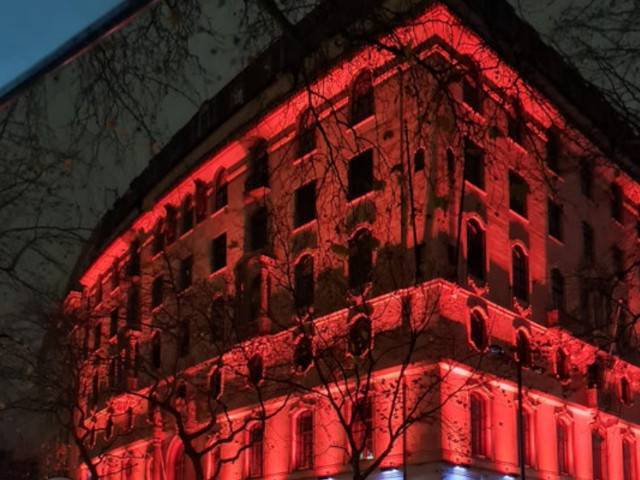World Voice Day

Landmarks across Australia are lighting up red – the colour of our larynx – on World Voice Day 2022 (April 16), to shine a light on voice disorders (dysphonia). The goal of the campaign spearheaded by the Australian Dysphonia Network (ADN), is to bring attention to the human voice, to start conversations about voice health and dysphonia and to symbolise the need to value our voice in the same way we value our vision and hearing [learn more with this short video: "The Value of Voice"].
Chronic dysphonia can develop for a number of reasons. It can be the result of damage to the larynx; underlying health conditions; overuse or poor vocal technique, or it can be a standalone neurological disorder like Spasmodic Dysphonia. Whilst rare, spasmodic dysphonia is thought to affect 1 in every 100,000 people in Australia including singer Jenny Morris. International celebrities like Robert F. Kennedy, Jr. and Scott Adams, the creator of "Dilbert," have also had their lives and careers impacted by the condition.
Spasmodic dysphonia is akin to an eye twitch, caused by a spasm of the muscle around your eye. For someone with spasmodic dysphonia, they have a very similar spasm but in a muscle in their larynx causing the voice to sound gravelly, crackle, sound breathy or drop out completely while speaking, and making communication difficult.
Vocal function is very often taken for granted. Most Australians will relate to the frustration of having lost their voice at some time, usually after a big night out, belting out your go-to karaoke songs or cheering at a football game, but for those with dysphonia, that frustration is a permanent way of life.
Approximately 30% of occupations in modern societies are voice dependent. This includes performers, teachers, salespeople, politicians, lawyers, to name a few, so the impact of dysphonia is life changing. It can ruin careers, relationships and lead to depression, yet it is often poorly diagnosed and frequently misunderstood. The Australian Dysphonia Network is using World Voice Day and their 'illumination campaign' to shine some light on voice disorders in the hope of gaining better understanding of those affected.
Established in 2016, the Australian Dysphonia Network's (ADN) purpose is to support people whose lives are impacted by a voice disorder with the Network run by people who either live with a voice disorder, or have a close experience of supporting someone who does.
World Voice Day was founded in Brazil back in 1999 with the aim of drawing attention to the science and phenomenon of voice production. It soon grew to highlight the significant role that the voice plays in every aspect of our daily lives. World Voice Day has gained momentum across the globe, and currently over 50 countries join the annual celebration.
Visit www.australiandysphonianetwork.org for more information. Donations for the not-for-profit charity
Below is a list of the Australian landmarks that are being illuminated for World Voice Day:
WESTERN AUSTRALIA
The Bell Tower – Perth
Council House – Perth
Trafalgar Bridge – East Perth
Hay Street – Perth
Crown Casino – Perth
Brockman Street – Manjimup
City of Busselton Building – Busselton
Koombana Footbridge – Bunbury
Foreshore – Bunbury
Marlston Hill Lookout – Bunbury
Marlston Waterfront
Guppy Park – Bunbury
Navigators & Loombana Dr (roundabouts) – Bunbury
Richmond Reserve – Perth
Historic Arrol Crane on Jetty Road – Bunbury
QV1 "Ring of Confidence" – Perth
Optus Stadium – Perth
Mount Street Bridge – Perth
Sky Ribbon Bridge – Perth
NorthBridge Tunnel – Perth
Town Square – Albany
Mandurah Bridge – Mandurah
VICTORIA
Melbourne Cricket Ground – Melbourne
AAMI Park – Melbourne (April 17)
Mooroopna Water Tower – Shepparton
Riverlinks Eastbank – Shepparton
The Monash Park Tree – Shepparton
Federation Square – Melbourne
Centenary Lights – Geelong
NEW SOUTH WALES
Newcastle Clock Tower – Newcastle
Lake Macquarie Council – Lake Macquarie
Speers Point – Lake Macquarie
Multi-Arts Pavilion (MAP mima) – Lake Macquarie
The Glasshouse – Port Macquarie
Macksville Bridge – Nambucca Valley Council
AUSTRALIAN CAPITAL TERRITORIES
Telstra Tower – Canberra
TASMANIA
Paranaple Convention Centre – Devonport
Launceston Town Tall – Launceston
Cardinal Lights (Mawson Place) – Hobart
Doone Kennedy Hobart Aquatic Centre – Hobart
Elizabeth Mall – Hobart
Franklin Square Fountain – Hobart
Rose Garden Bridge – Hobart
QUEENSLAND
Storey Bridge – Brisbane
City Hall – Brisbane
Victoria Bridge – Brisbane
Raddaclif Place – Brisbane
Kurilpa Bridge – Brisbane
Brisbane Sculptures – Brisbane
Donna Marcus Stream 2006 – Brisbane
Tropical Dome – Brisbane Botanical Gardens
Toowoomba City Hall Annexe – Toowoomba
Q1 Tower – Gold Coast
Isle of Capri Bridge – Gold Coast
Moreton Bay – Caboolture Hub
Moreton Bay – Redcliffe Admin Centre
Humpybong Creek Fountain – Redcliffe
Under seat Scarborough Beach Park – Scarborough
City Hall – Maryborough
Sandgate Town Hall – Sandgate
Longreach Water Tower – Longreach
Rockhampton City Council – Rockhampton
SOUTH AUSTRALIA
Adelaide Oval – Adelaide (April 18)
Port Adelaide Light House – Port Adelaide
Adelaide Convention Centre – Adelaide (April 18)
Town Hall Building – City of Unley
Adelaide Town Hall – Adelaide
Victoria Square Fountain – Adelaide
Adelaide River Footbridge – Adelaide
Charles Sturt Community Lights – Adelaide
NORTHER TERRITORY
Palmerston Water Tower – Palmerston
Francis Drive Light Pole – Palmerston
Chronic dysphonia can develop for a number of reasons. It can be the result of damage to the larynx; underlying health conditions; overuse or poor vocal technique, or it can be a standalone neurological disorder like Spasmodic Dysphonia. Whilst rare, spasmodic dysphonia is thought to affect 1 in every 100,000 people in Australia including singer Jenny Morris. International celebrities like Robert F. Kennedy, Jr. and Scott Adams, the creator of "Dilbert," have also had their lives and careers impacted by the condition.
Spasmodic dysphonia is akin to an eye twitch, caused by a spasm of the muscle around your eye. For someone with spasmodic dysphonia, they have a very similar spasm but in a muscle in their larynx causing the voice to sound gravelly, crackle, sound breathy or drop out completely while speaking, and making communication difficult.
Vocal function is very often taken for granted. Most Australians will relate to the frustration of having lost their voice at some time, usually after a big night out, belting out your go-to karaoke songs or cheering at a football game, but for those with dysphonia, that frustration is a permanent way of life.
Approximately 30% of occupations in modern societies are voice dependent. This includes performers, teachers, salespeople, politicians, lawyers, to name a few, so the impact of dysphonia is life changing. It can ruin careers, relationships and lead to depression, yet it is often poorly diagnosed and frequently misunderstood. The Australian Dysphonia Network is using World Voice Day and their 'illumination campaign' to shine some light on voice disorders in the hope of gaining better understanding of those affected.
Established in 2016, the Australian Dysphonia Network's (ADN) purpose is to support people whose lives are impacted by a voice disorder with the Network run by people who either live with a voice disorder, or have a close experience of supporting someone who does.
World Voice Day was founded in Brazil back in 1999 with the aim of drawing attention to the science and phenomenon of voice production. It soon grew to highlight the significant role that the voice plays in every aspect of our daily lives. World Voice Day has gained momentum across the globe, and currently over 50 countries join the annual celebration.
Visit www.australiandysphonianetwork.org for more information. Donations for the not-for-profit charity
Below is a list of the Australian landmarks that are being illuminated for World Voice Day:
WESTERN AUSTRALIA
The Bell Tower – Perth
Council House – Perth
Trafalgar Bridge – East Perth
Hay Street – Perth
Crown Casino – Perth
Brockman Street – Manjimup
City of Busselton Building – Busselton
Koombana Footbridge – Bunbury
Foreshore – Bunbury
Marlston Hill Lookout – Bunbury
Marlston Waterfront
Guppy Park – Bunbury
Navigators & Loombana Dr (roundabouts) – Bunbury
Richmond Reserve – Perth
Historic Arrol Crane on Jetty Road – Bunbury
QV1 "Ring of Confidence" – Perth
Optus Stadium – Perth
Mount Street Bridge – Perth
Sky Ribbon Bridge – Perth
NorthBridge Tunnel – Perth
Town Square – Albany
Mandurah Bridge – Mandurah
VICTORIA
Melbourne Cricket Ground – Melbourne
AAMI Park – Melbourne (April 17)
Mooroopna Water Tower – Shepparton
Riverlinks Eastbank – Shepparton
The Monash Park Tree – Shepparton
Federation Square – Melbourne
Centenary Lights – Geelong
NEW SOUTH WALES
Newcastle Clock Tower – Newcastle
Lake Macquarie Council – Lake Macquarie
Speers Point – Lake Macquarie
Multi-Arts Pavilion (MAP mima) – Lake Macquarie
The Glasshouse – Port Macquarie
Macksville Bridge – Nambucca Valley Council
AUSTRALIAN CAPITAL TERRITORIES
Telstra Tower – Canberra
TASMANIA
Paranaple Convention Centre – Devonport
Launceston Town Tall – Launceston
Cardinal Lights (Mawson Place) – Hobart
Doone Kennedy Hobart Aquatic Centre – Hobart
Elizabeth Mall – Hobart
Franklin Square Fountain – Hobart
Rose Garden Bridge – Hobart
QUEENSLAND
Storey Bridge – Brisbane
City Hall – Brisbane
Victoria Bridge – Brisbane
Raddaclif Place – Brisbane
Kurilpa Bridge – Brisbane
Brisbane Sculptures – Brisbane
Donna Marcus Stream 2006 – Brisbane
Tropical Dome – Brisbane Botanical Gardens
Toowoomba City Hall Annexe – Toowoomba
Q1 Tower – Gold Coast
Isle of Capri Bridge – Gold Coast
Moreton Bay – Caboolture Hub
Moreton Bay – Redcliffe Admin Centre
Humpybong Creek Fountain – Redcliffe
Under seat Scarborough Beach Park – Scarborough
City Hall – Maryborough
Sandgate Town Hall – Sandgate
Longreach Water Tower – Longreach
Rockhampton City Council – Rockhampton
SOUTH AUSTRALIA
Adelaide Oval – Adelaide (April 18)
Port Adelaide Light House – Port Adelaide
Adelaide Convention Centre – Adelaide (April 18)
Town Hall Building – City of Unley
Adelaide Town Hall – Adelaide
Victoria Square Fountain – Adelaide
Adelaide River Footbridge – Adelaide
Charles Sturt Community Lights – Adelaide
NORTHER TERRITORY
Palmerston Water Tower – Palmerston
Francis Drive Light Pole – Palmerston
MORE





